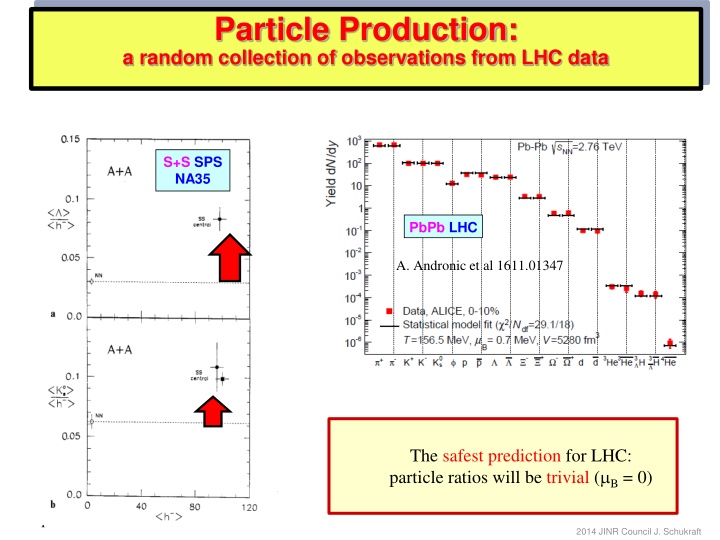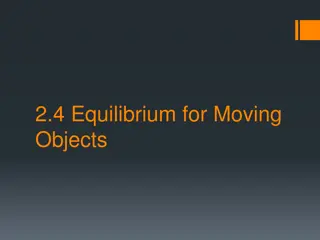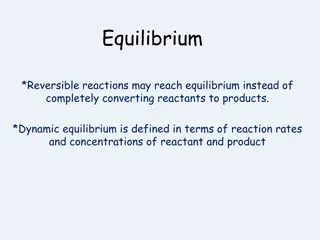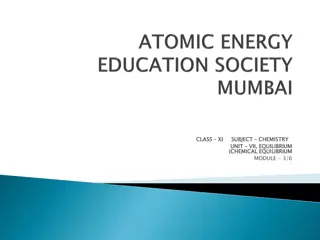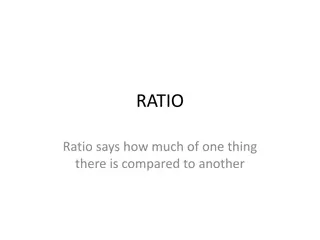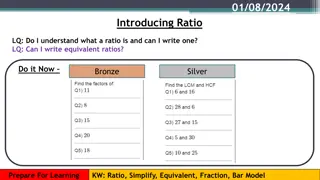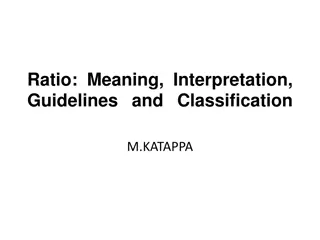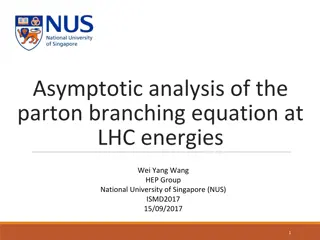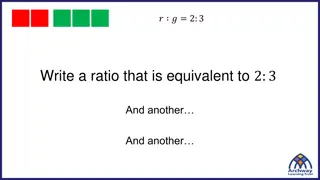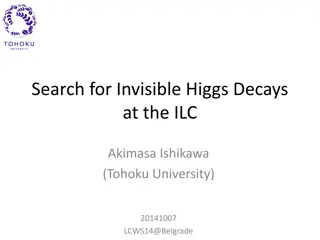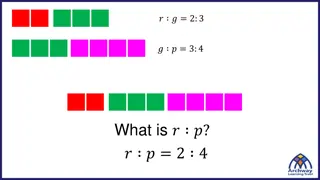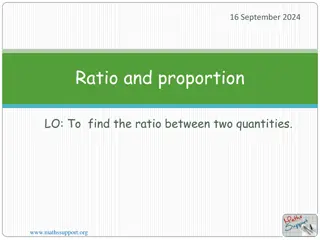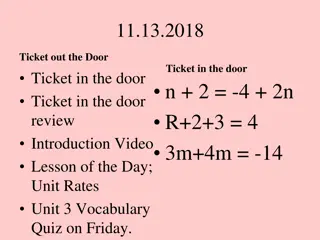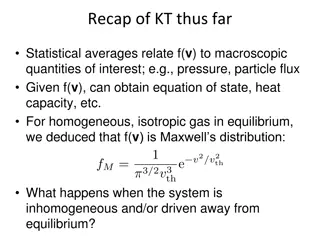Insights into Particle Ratios and Equilibrium Dynamics at LHC
Collection of observations from LHC data regarding particle ratios and the successful Thermal Model. Discusses the concept of equilibrium, onset of equilibrium, relationship to QGP phase, and potential solutions through out-of-equilibrium studies. Also delves into size/volume dependence, strangeness enhancement, and the distinction between core and corona in non-equilibrium systems.
Download Presentation

Please find below an Image/Link to download the presentation.
The content on the website is provided AS IS for your information and personal use only. It may not be sold, licensed, or shared on other websites without obtaining consent from the author.If you encounter any issues during the download, it is possible that the publisher has removed the file from their server.
You are allowed to download the files provided on this website for personal or commercial use, subject to the condition that they are used lawfully. All files are the property of their respective owners.
The content on the website is provided AS IS for your information and personal use only. It may not be sold, licensed, or shared on other websites without obtaining consent from the author.
E N D
Presentation Transcript
Particle Production: a random collection of observations from LHC data S+S SPS NA35 PbPb LHC A. Andronic et al 1611.01347 The safest prediction for LHC: particle ratios will be trivial ( B = 0) 1 2014 JINR Council J. Schukraft
The unreasonably successful Thermal Model Dozens of particle ratios with very few parameters (Tchem, B, s, c.) e+e-, pp, pA, AA : very intuitive physics very efficient and fairly accurate description (compared to everything else, eg MC) .. not sure how and why this works so well ! evolvinginto equilibrium A + B C + D (hadronic or partonic pressure cooker + detailed balance) borninto equilibrium A + B => C + D (Fermi s Golden Rule & phase space dominance) both plausible ideas, but little (no?) experimental proof .. not sure how or if this is connected to the QGP (partonic) phase (vacuum) hadron masses enter the PS formula, not parton masses (ex s, c.) Connection to QGP either conspiracy (of fugacities) or conjecture Blessing & Curse of Equilibrium: No memory of past ! No need for Dynamics e+e- LEP ppRHIC If Equilibrium is the Problem, Out-of-Equilibrium may be a Solution: Study out-of-equilibrium signals => test Dynamics at work Fluctuations around Equilibrium II) Onset/Approach to (or sequential freeze-out from) Equilibrium I) QM17 Chicago J. Schukraft 2
Size/Volume Dependence (the onset?) Smooth Evolution from MinBias pp to central AA (~ dN/d , , 1/S dN/dy, .. ?) Strangeness Enhancement pp pA AA I) No obvious mechanism for Born into Phase Space w/o IS or FS Interaction => Phase Space = linear superposition Change PS via string fusion, a la Dipsy ? see also H Satz (change string tension) needs interactions => born evolves towards evolving PbPb pp, pPb Alice 1606.07424 QM17 Chicago J. Schukraft 3
Size/Volume Dependence (the onset?) II) Exact strangeness conservation => sCanonical pretty good for open strangeness, also for light nuclei (incl. baryon conservation) fails utterly for the fails dramatically for p/ pp, pA, AA: Normalized particle ratios vs Nch 1808.05245 1803.05409 Priv. Comm. 1610.03001 QM17 Chicago J. Schukraft 4
Size/Volume Dependence (the onset?) III) Core(equil)+ Corona (non-equil): many parameters (free fit to Corona fraction) => modest accuracy Core/Corona definition in pA questionable Does NOT address pp (e+e-) ratios Priv. Comm. 1610.03001 QM17 Chicago J. Schukraft 5
II) Non-equilibrium ratios(sequential FO)? Different particles -> different x-sections ( , r) -> differential freeze-out Tchem Smoking gun of chemical dynamics, we should look for it ! Alice Phys. Lett. B 728 (2014) 25-38 p Alice Phys. Rev. C 91 024609 (2015) weak indication of FS chemistry( baryon annihilation ) - Reproduced by transport MC (URQMD, EPOS) (model dependence, parameters, detailed balance,..) - Needs better dataO(5%) accuracy to firmly establish s (RHIC-BES -> LHC), dN/dy(pp -> AA) - Other large x-section particles ? Not chemistry, but kinetics (decay + re-scattering) Proof & nontrivial test of kinetic phase ! Incompatible with single FO (Tchem=Tkin) ! => Transport & Dynamics in HRG (~1fm) < K*(~4fm) < *(~13fm) < *(<22fm)< (~45fm) Could make, not brake, the case for hadro-chemistry QM17 Chicago J. Schukraft 6
II) Light Nuclei: Return of the old Enigma Thermal: Tchem (d, 3H , 3He) = 156 4 MeV (strongly disfavors non-equil. s, q 1) Survive Tkin expansion ? E(3H ) 100 KeV, dissociation huge( +d 10 s mb, PRL 48, 577) Isentropic => Entropy/Baryon = c = d/p. True (at Bevalac). But what keeps E/B ? Chemical equilibrium may be (part of) the answer IFF the equilibrium value does NOT depend on the (decreasing) T See eg 1809.04024 (Dmytro, Volker, ..), Ulli, .. Arrhenius equitation k = exp(- E/T), E/T << 1 Tchem( , K, p, , ..) = 156 2 MeV Thermal Model ALICE PRC 93 (2015) 024917 d, 3H , 3He dN/dy Pb-Pb 0-10% pPb: d/p rises while p/ = c Data/TH model QM17 Chicago J. Schukraft 7
II) Light Nuclei: Return of the old Enigma Coalesence@Tkin: Simple models fix ratios to data => get kinetic (pT, v2) distributions (approx.) right Kinetic distributions (flow) better described using Hydro + Coalesence 1807.02813 Ab Initio Wigner yield calculations are typically off by factors O(>2-8) 1607.0226, 1512.00692 Compare similar mass, different size nuclei (3He/3 H) Thermal Model (T, m) Coalescence ( (r), (x,t)) Deuteron v2(pT) Naive Coalesence Little Bang Nucleosynthesis progress but not quite solved yet Thermal + Kinetic : - yields & kinematics - survival ?( )pA ? ( > R ??) Coalescence: - Survival kinematics - Yield = Tchem by accident ? BlastWave Tchem ->Tkin QM17 Chicago J. Schukraft 8
Hadronisation How: macroscopic /statistical/thermal Model: elegant/simple/efficient Why: Hadronisation: Several Promising Leads but no coherent & complete picture pp pA AA - Data plenty, smaller errors may help may want confirmation from RHIC (BES and pp, pA) - Ball now with Theory/new Ideas Color Ropes (Dipsy/1412.6259), thermal string decay (1610.09818), Unruh radiation(0704.1426), string fusion(hep-ph/0103060), flavor differential FO(1305.6297), missing resonances (1701.07346), .. - Significant recent progress helped by new high quality data and small systems The safest prediction for LHC: particle ratios will be trivial ( B = 0) QM17 Chicago J. Schukraft 9
1702.00486 + d + n + p Inelastic + d + d Elastic + d + n + n ChargeEx (inel+CEX) >> (elastic) = = chem << kin Why Tchem >> Tkin ?? 10 QM17 Chicago J. Schukraft
S-Canonical & Core Corona Fits f = optimal Core Fraction for each particle individually QM17 Chicago J. Schukraft 11
